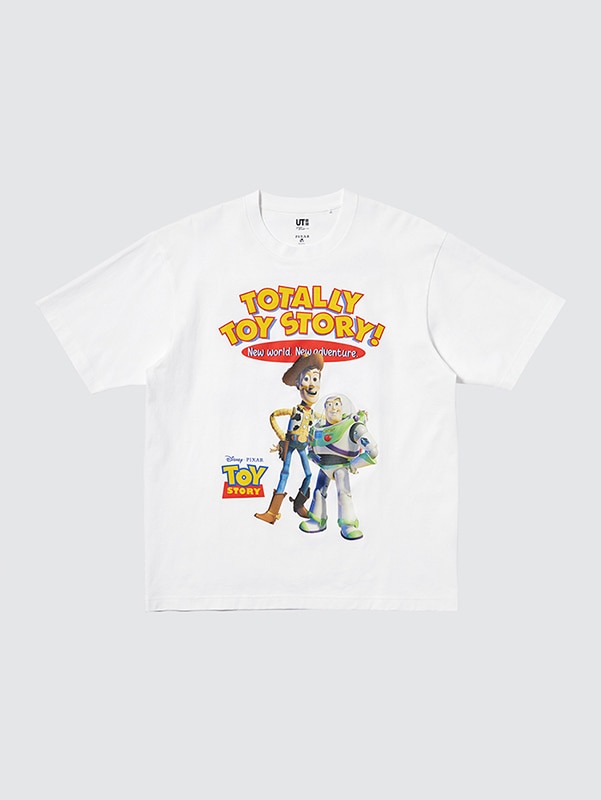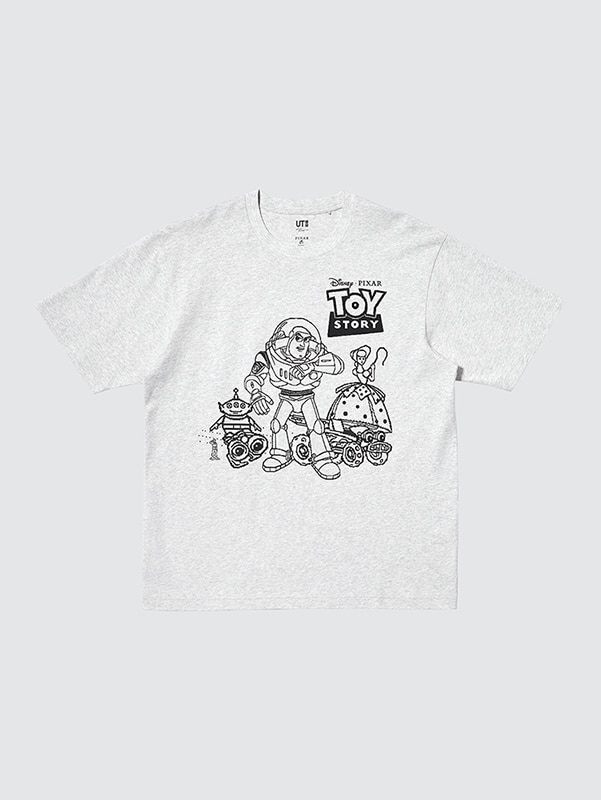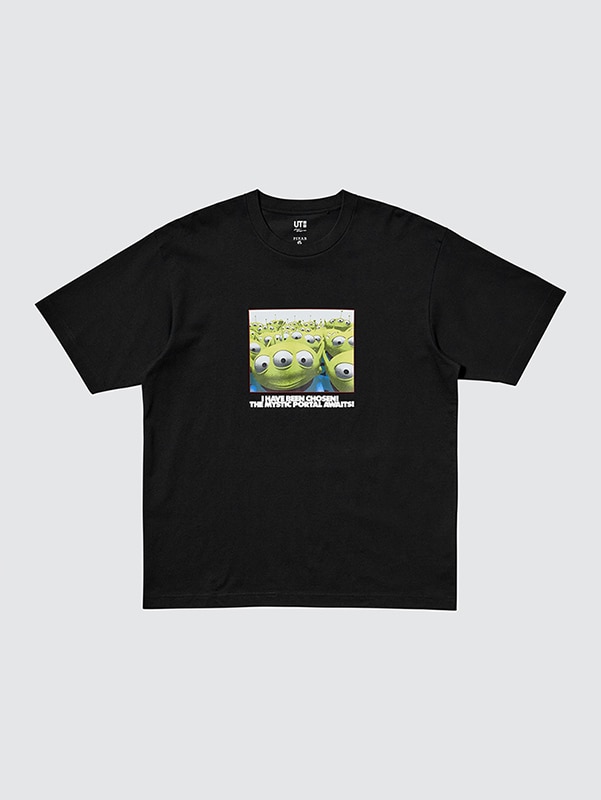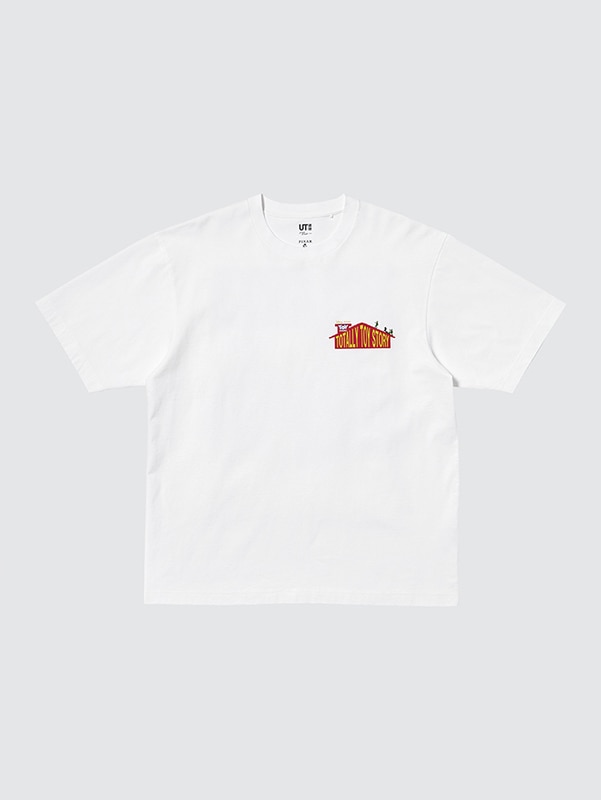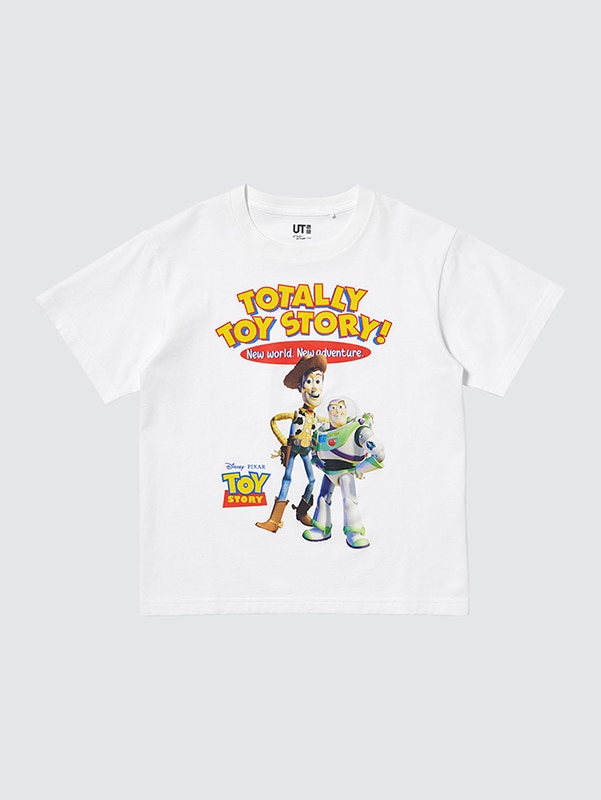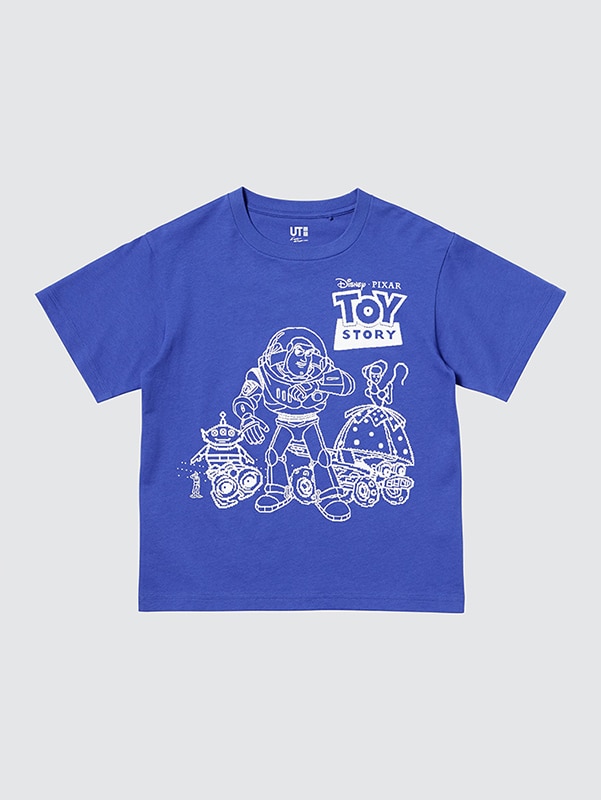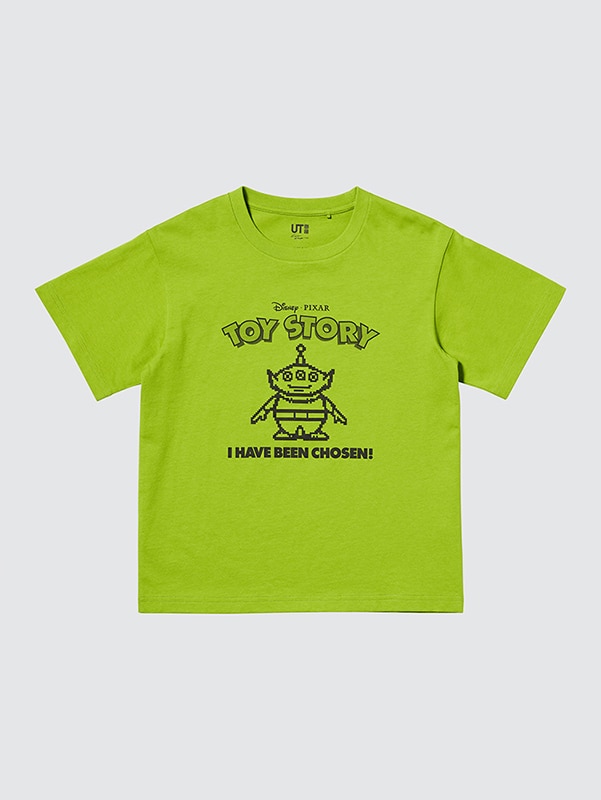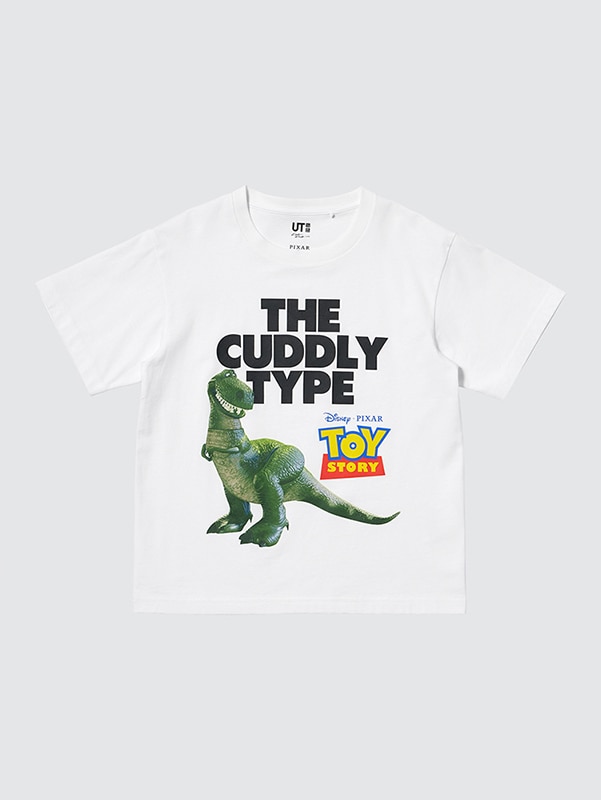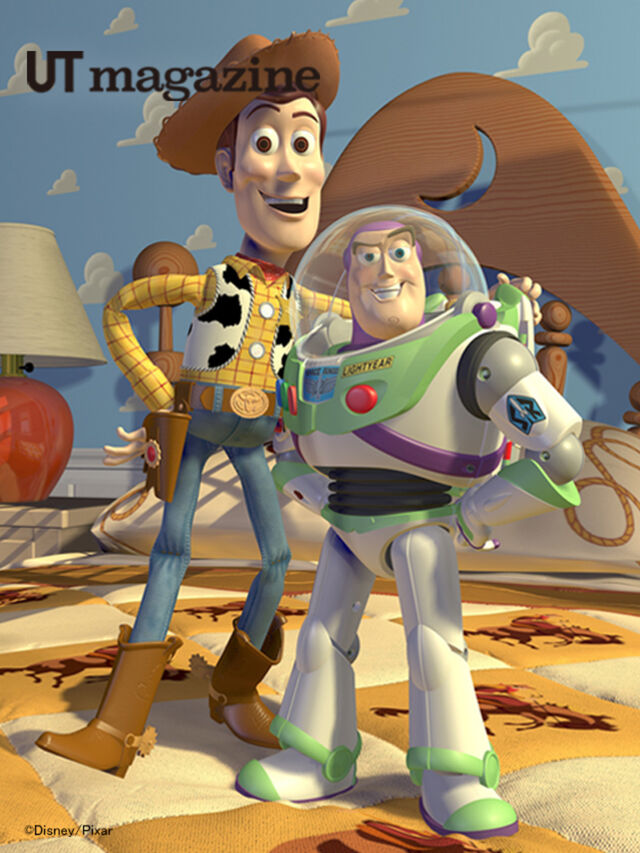
Interview with Toy Story Production Designer Bob Pauley Celebrating 30 Years of Friendship
Jul 17, 2025
UT
Thirty years ago, Toy Story, the earnest tale told from the toys’ perspective, captured our hearts in the theater with its colorful characters, humor, and sense of adventure. Sequels and shorts followed the original, and as generations of audiences grew up, there was always a new story to look forward to. And now the Pixar team is once again going to gift us with another adventure: Toy Story 5*. Earlier this spring, one of the original Production Designers, Bob Pauley, took time out from the busy production schedule to chat with us.
*US theater release in 2026. Japan release and world release are TBA.
View items
Q. So, you are working on Toy Story 5 as we speak! How exciting!
Yes, the art department is at crunch time! We have got most of the new characters done and are now working on the environments and locations. I feel so lucky to be with all these great characters again, and there are many new ones as well, with some enjoyable opportunities. There are people on this team, like me, who were involved in the very first Toy Story, and others who are working on this project for the first time. So, it’s kind of magic. Really sweet, and a good team. I’m enjoying it.
Q. Toy Story came out in 1995, and 4 films later, we still can’t seem to get enough of it. Why do you think the story stayed relevant beyond the passage of time?
I think the movies are entertaining, but it's the characters that truly connect with us. They are not just silly toys but are a large ensemble of characters with real problems and concerns. Many people could pick a Toy Story character, such as Rex or Potato Head, and recognize who they are. They are almost like a big family—living in the same room together, and their mutual project is to take care of this child. I also love how some of the characters play against type. You have this ferocious-looking dinosaur toy, which many kids had back then, but he’s just a clumsy, sweet guy. We’ve been fortunate to create these wonderful roles that seem to form deep connections with people. I’m in the art department designing characters, but there’s a story team, directors, and it’s a whole world of collaboration. Also, I think the Toy Story movies are surprising at times and take you to places you don’t always expect to go. In Toy Story 3, Andy is leaving home for college. For many of us, our kids were reaching college age, so we were in tears watching the early versions of it. I believe that having stories that resonate with people on a genuine level is very important.
Q. In Toy Story, how the narrative is being driven from the perspective of toys themselves was very authentic, unique, and imaginative. As one of the creators, how do you regard the relationship between humans and toys?
That sort of magic childhood time when you are roleplaying, acting things out, or engrossed in storytelling with the toys that you have–that is a special time. And that is also a very small window of time that toys get to be with children. I remember when I was 6, Hot Wheels came out, and that blew my mind. I loved them! I have a picture of me from Christmas morning with all my Hot Wheels. Toys emerge at specific times, and people connect—and that creates an era of toys. I was in the era of Hot Wheels and G.I. Joe! You get connected to these things and make memories. These toys are your friends. For me, when I think of Hot Wheels and similar items, it takes me back to that time, so toys are, in a way, touchstones too. That’s why people will have that little toy at their desk, or something that reminds them of it, because those were the good times. It's a little at Pixar; we're adults who have toys everywhere.
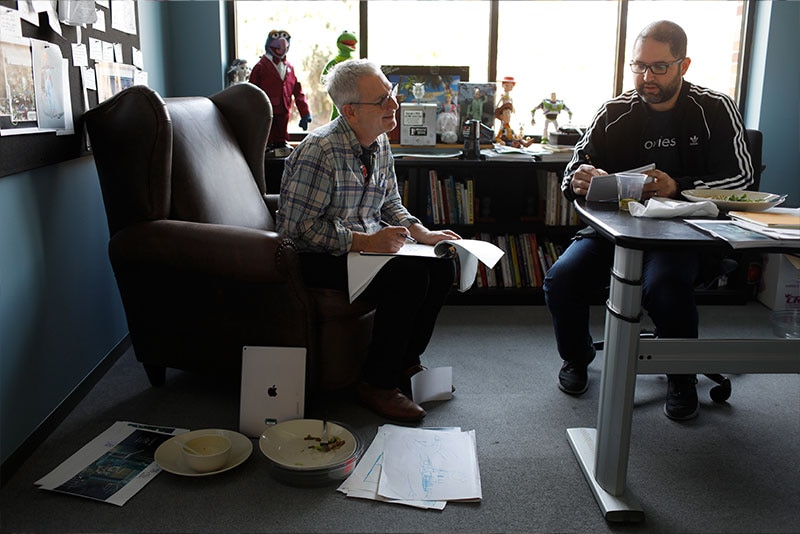
Q. Hot Wheels being one of your touchstones—it makes sense! As a production designer and the main character designer behind Buzz Lightyear, I learned that you are also really into car design.
It is entirely connected to my childhood, when I was all into Hot Wheels and model kits. Being in California, I saw many car designs around me. That was something that helped me out a great deal while working on one Cars movie. I was also very ‘aware’ of toys. When you're playing with these, you look at all the details, right? For a small child, details are really important. In the first Toy Story, as accurately as possible, we wanted to be true to the materials, their mechanics, the sounds they make, and how they bend. Because kids touch those little screws and other objects, they become familiar with them. Those elements were super critical to us; we wanted to be authentic in that way. It was also important not to shy away from the toys’ limitations. Because that is like all of us. We have limitations, and we find ways to work with them or work around them. Those confinements are the things that come to define the characters, and we had fun working with them.
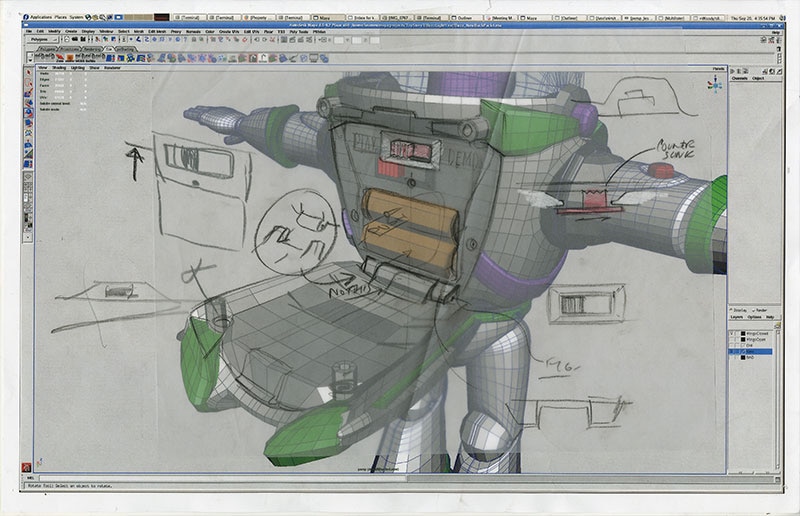
Q. It’s true, restrictive movement, or the function of a toy, gives the child more imaginative space or more connection because you have to come up with solutions in their world.
Yes, it’s terrific! Rex has these little, tiny arms. You make jokes about that, but that is him! The fun part is that he knows that, and he has a big, clunky tail that knocks everything over. Potato Head loses his parts, which is another funny thing. He’s always looking for the parts. Dogs are loyal, so Slinky Dog is loyal to Woody. Slinky is representative of a particular era of toys. But that was 30 years ago. Some of these younger designers in the team are tapping into their history, which is closer to young people now than mine. They are finding things that resonate with them. It is fun to explore “what if it could be this character?” or “what are the things that make that character special?” And somebody will say, “Well, I remember playing with these things! What was special to me was the sound that it made, the texture of the plastic, or how it rattled.” There are various ways to connect with them. I think it's fun to explore how different generations approach it. You will see that in Toy Story 5, there are some new toys from more contemporary times.

Q. You happened to hold up Buzz Lightyear when you were talking about material and details in toys. It is a well-known fact that you made the very early character sketch of Buzz—was there a specific inspiration behind him or his character?
Yes, it’s my drawing, but Eben Ostby was the modeler, and a lot of people were behind making him look that good. And together, as a team, we created something that is still around today! I’m fortunate that these characters came together and that their designs have lasting appeal to people. Kids grow up with this stuff. It’s very heartwarming.
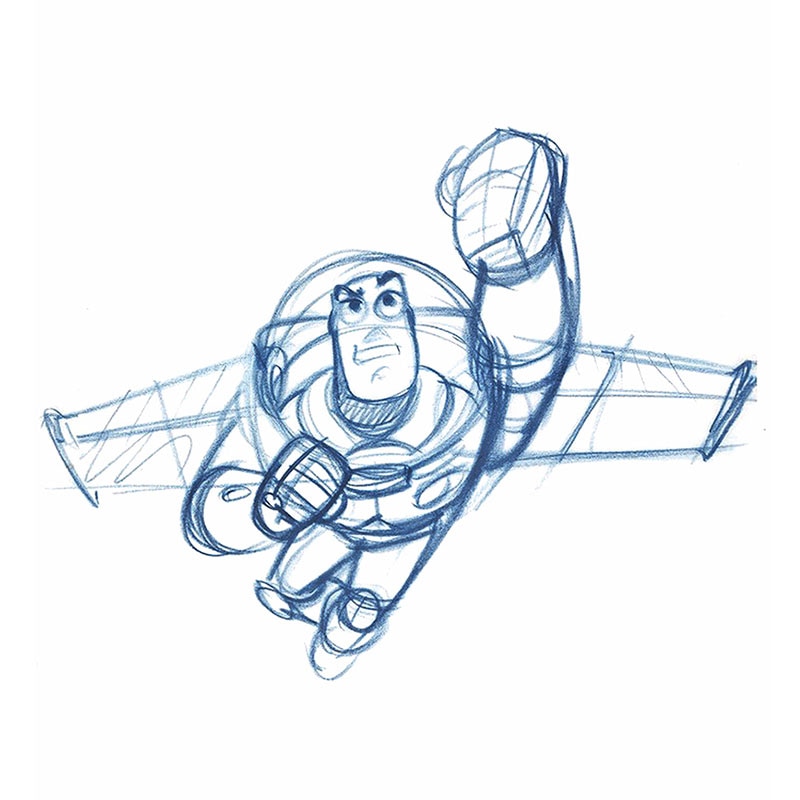
I think the main tension we tried to instill in Buzz is that it’s a buddy movie, and these guys at first are antagonistic with each other. Eventually, they have learned to work together and become friends, but with the western cowboy and the new space era astronaut, a clash was inevitable. For Andy, his older hand-me-down cowboy is no longer as exciting as the space guy. So, we had to make Buzz cool, with voice simulators and laser stuff. All those latest things that kind of put Woody to shame. To work out Buzz’s body, I remember John Lasseter, the director, telling me to channel NASA. So Buzz has little fingertips that are referencing the astronaut’s suit from back then. And of course, he had to have wings and a jetpack. I used to commute to work on a train; the train had white stripes in front. John pointed to the train stickers and said, “Oh, I like those stripes!” So, we drew inspiration from many sources. In contrast to Woody, this old, worn-out cowboy, we wanted Buzz to be a bit fancier, with lights and all the buttons, and we had made him a little shorter with a bit more mass. Buzz moves with intention; he’s very strong and tough. But is he going to fly? He doesn’t fly, right? But with kids’ hands, with wings up, he flies! You just have to believe and be imaginative.
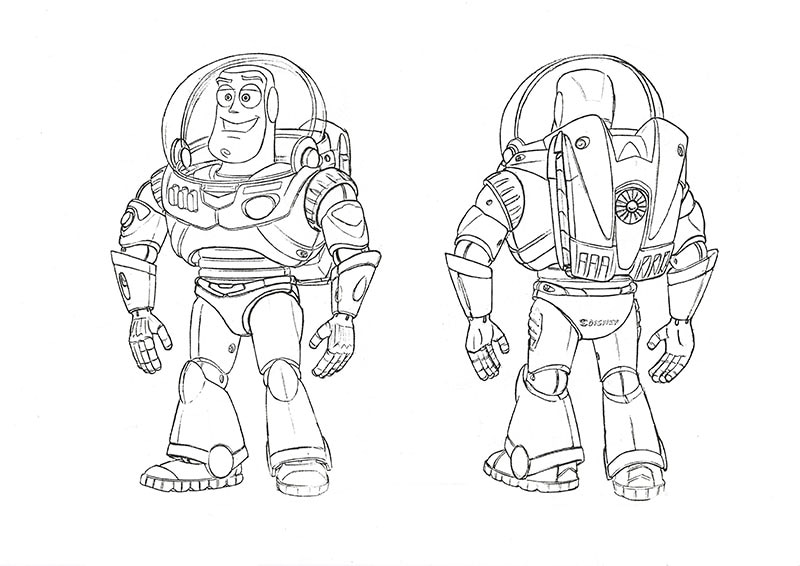
Q. To have Pixar and Toy Story be part of the 10th anniversary release for Uniqlo’s “MAGIC FOR ALL” is very special. Toy Story has gone into people’s lives beyond the film in many different forms, but how do you feel about these T-shirts going out into the world as something you can wear?
I can’t wait to see one on the street! Someone wearing them would be super fun. I mean, you are picking some iconic images! The one with Buzz and Woody - that’s a great pose featured on a poster. I think Pete Docter did that pose. Some of them are very early renders, which retain a certain naïve charm in a way. It is joyful looking back at those things because I have fond memories of that time. Some beautiful renderings are being created in the process, but ideally, nobody sees any of them, because film is our product. But when you look behind the scenes, there is just so much lovely artwork. It's nice to be part of something where such care and attention are given to the individual designs and artwork, for a story that's so well-written.
Q. As Toy Story 5 is set to release in the US in 2026, do you have any message for people who are anticipating the drop, who are fans of the Toy Story world?
Toy Story 5—the show has a lot of great positive energy, and everyone is having a blast because we believe in the story. And we love the new characters. I would say I’m excited for you because you don’t know what's coming, and it's going to be a lot. So, hang tight, we are getting it done as fast as we can, but it’s well worth the wait. There are animators on the show who have never worked on a Toy Story project. The amusing thing was that they had to load the characters into their computer to work on them, much like opening a toy box. They get to open Buzz, or Woody, or whatever character they are animating for the first time, and play with them. In a meta way, we are playing with the toys. But it is also a privilege because these are the characters that now have four movies behind them. What the animators are doing is adding to that legacy and bringing it forward, but it's a complete joy when you're doing it. You don’t think about, “Wow, this is important. This is going to last.” I think that’s where you are getting into almost a childlike way of playing with toys. It's hard work, but I can’t complain because it's fun to design new toys or animate classic ones. This is a privilege, an enjoyable and exciting place to be, so we are lucky. Very, very lucky.
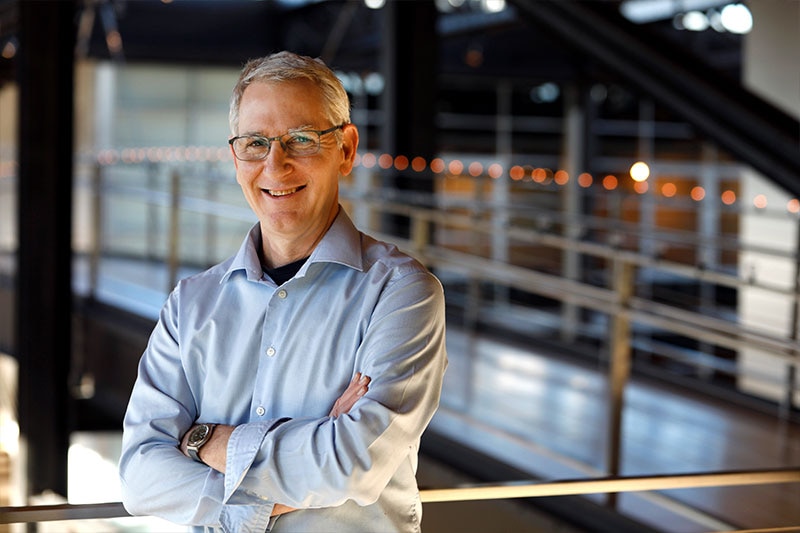
*US theater release in 2026. Japan release and world release are TBA.
View items
Q. So, you are working on Toy Story 5 as we speak! How exciting!
Yes, the art department is at crunch time! We have got most of the new characters done and are now working on the environments and locations. I feel so lucky to be with all these great characters again, and there are many new ones as well, with some enjoyable opportunities. There are people on this team, like me, who were involved in the very first Toy Story, and others who are working on this project for the first time. So, it’s kind of magic. Really sweet, and a good team. I’m enjoying it.
Q. Toy Story came out in 1995, and 4 films later, we still can’t seem to get enough of it. Why do you think the story stayed relevant beyond the passage of time?
I think the movies are entertaining, but it's the characters that truly connect with us. They are not just silly toys but are a large ensemble of characters with real problems and concerns. Many people could pick a Toy Story character, such as Rex or Potato Head, and recognize who they are. They are almost like a big family—living in the same room together, and their mutual project is to take care of this child. I also love how some of the characters play against type. You have this ferocious-looking dinosaur toy, which many kids had back then, but he’s just a clumsy, sweet guy. We’ve been fortunate to create these wonderful roles that seem to form deep connections with people. I’m in the art department designing characters, but there’s a story team, directors, and it’s a whole world of collaboration. Also, I think the Toy Story movies are surprising at times and take you to places you don’t always expect to go. In Toy Story 3, Andy is leaving home for college. For many of us, our kids were reaching college age, so we were in tears watching the early versions of it. I believe that having stories that resonate with people on a genuine level is very important.
Q. In Toy Story, how the narrative is being driven from the perspective of toys themselves was very authentic, unique, and imaginative. As one of the creators, how do you regard the relationship between humans and toys?
That sort of magic childhood time when you are roleplaying, acting things out, or engrossed in storytelling with the toys that you have–that is a special time. And that is also a very small window of time that toys get to be with children. I remember when I was 6, Hot Wheels came out, and that blew my mind. I loved them! I have a picture of me from Christmas morning with all my Hot Wheels. Toys emerge at specific times, and people connect—and that creates an era of toys. I was in the era of Hot Wheels and G.I. Joe! You get connected to these things and make memories. These toys are your friends. For me, when I think of Hot Wheels and similar items, it takes me back to that time, so toys are, in a way, touchstones too. That’s why people will have that little toy at their desk, or something that reminds them of it, because those were the good times. It's a little at Pixar; we're adults who have toys everywhere.

Q. Hot Wheels being one of your touchstones—it makes sense! As a production designer and the main character designer behind Buzz Lightyear, I learned that you are also really into car design.
It is entirely connected to my childhood, when I was all into Hot Wheels and model kits. Being in California, I saw many car designs around me. That was something that helped me out a great deal while working on one Cars movie. I was also very ‘aware’ of toys. When you're playing with these, you look at all the details, right? For a small child, details are really important. In the first Toy Story, as accurately as possible, we wanted to be true to the materials, their mechanics, the sounds they make, and how they bend. Because kids touch those little screws and other objects, they become familiar with them. Those elements were super critical to us; we wanted to be authentic in that way. It was also important not to shy away from the toys’ limitations. Because that is like all of us. We have limitations, and we find ways to work with them or work around them. Those confinements are the things that come to define the characters, and we had fun working with them.

Q. It’s true, restrictive movement, or the function of a toy, gives the child more imaginative space or more connection because you have to come up with solutions in their world.
Yes, it’s terrific! Rex has these little, tiny arms. You make jokes about that, but that is him! The fun part is that he knows that, and he has a big, clunky tail that knocks everything over. Potato Head loses his parts, which is another funny thing. He’s always looking for the parts. Dogs are loyal, so Slinky Dog is loyal to Woody. Slinky is representative of a particular era of toys. But that was 30 years ago. Some of these younger designers in the team are tapping into their history, which is closer to young people now than mine. They are finding things that resonate with them. It is fun to explore “what if it could be this character?” or “what are the things that make that character special?” And somebody will say, “Well, I remember playing with these things! What was special to me was the sound that it made, the texture of the plastic, or how it rattled.” There are various ways to connect with them. I think it's fun to explore how different generations approach it. You will see that in Toy Story 5, there are some new toys from more contemporary times.

Q. You happened to hold up Buzz Lightyear when you were talking about material and details in toys. It is a well-known fact that you made the very early character sketch of Buzz—was there a specific inspiration behind him or his character?
Yes, it’s my drawing, but Eben Ostby was the modeler, and a lot of people were behind making him look that good. And together, as a team, we created something that is still around today! I’m fortunate that these characters came together and that their designs have lasting appeal to people. Kids grow up with this stuff. It’s very heartwarming.

I think the main tension we tried to instill in Buzz is that it’s a buddy movie, and these guys at first are antagonistic with each other. Eventually, they have learned to work together and become friends, but with the western cowboy and the new space era astronaut, a clash was inevitable. For Andy, his older hand-me-down cowboy is no longer as exciting as the space guy. So, we had to make Buzz cool, with voice simulators and laser stuff. All those latest things that kind of put Woody to shame. To work out Buzz’s body, I remember John Lasseter, the director, telling me to channel NASA. So Buzz has little fingertips that are referencing the astronaut’s suit from back then. And of course, he had to have wings and a jetpack. I used to commute to work on a train; the train had white stripes in front. John pointed to the train stickers and said, “Oh, I like those stripes!” So, we drew inspiration from many sources. In contrast to Woody, this old, worn-out cowboy, we wanted Buzz to be a bit fancier, with lights and all the buttons, and we had made him a little shorter with a bit more mass. Buzz moves with intention; he’s very strong and tough. But is he going to fly? He doesn’t fly, right? But with kids’ hands, with wings up, he flies! You just have to believe and be imaginative.

Q. To have Pixar and Toy Story be part of the 10th anniversary release for Uniqlo’s “MAGIC FOR ALL” is very special. Toy Story has gone into people’s lives beyond the film in many different forms, but how do you feel about these T-shirts going out into the world as something you can wear?
I can’t wait to see one on the street! Someone wearing them would be super fun. I mean, you are picking some iconic images! The one with Buzz and Woody - that’s a great pose featured on a poster. I think Pete Docter did that pose. Some of them are very early renders, which retain a certain naïve charm in a way. It is joyful looking back at those things because I have fond memories of that time. Some beautiful renderings are being created in the process, but ideally, nobody sees any of them, because film is our product. But when you look behind the scenes, there is just so much lovely artwork. It's nice to be part of something where such care and attention are given to the individual designs and artwork, for a story that's so well-written.
Q. As Toy Story 5 is set to release in the US in 2026, do you have any message for people who are anticipating the drop, who are fans of the Toy Story world?
Toy Story 5—the show has a lot of great positive energy, and everyone is having a blast because we believe in the story. And we love the new characters. I would say I’m excited for you because you don’t know what's coming, and it's going to be a lot. So, hang tight, we are getting it done as fast as we can, but it’s well worth the wait. There are animators on the show who have never worked on a Toy Story project. The amusing thing was that they had to load the characters into their computer to work on them, much like opening a toy box. They get to open Buzz, or Woody, or whatever character they are animating for the first time, and play with them. In a meta way, we are playing with the toys. But it is also a privilege because these are the characters that now have four movies behind them. What the animators are doing is adding to that legacy and bringing it forward, but it's a complete joy when you're doing it. You don’t think about, “Wow, this is important. This is going to last.” I think that’s where you are getting into almost a childlike way of playing with toys. It's hard work, but I can’t complain because it's fun to design new toys or animate classic ones. This is a privilege, an enjoyable and exciting place to be, so we are lucky. Very, very lucky.

Bob Pauley
Originally from Michigan and raised in San Jose, Bob Pauley earned a B.S. in Graphic Design from San Jose State University and now lives in Berkeley, California. He joined Pixar Animation Studios in 1993 as a character designer and sketch artist for Toy Story, where he contributed to the iconic design of Buzz Lightyear. He later served as art director on A Bug's Life and production designer on Monsters, Inc., Toy Story 3, and Toy Story 4. A lifelong car enthusiast, he also served as production designer on Cars, helping to shape the characters and world. Outside of film, he worked with Walt Disney Imagineering on the design of Cars Land at Disney California Adventure.

Created by Disney and Pixar, Toy Story is the world’s first full-length feature film made entirely with CGI animation. Woody, a cowboy doll, is young Andy’s favorite toy. But everything changes when Andy receives a brand-new, high-tech Space Ranger—Buzz Lightyear—for his birthday. Suddenly, Woody’s status is threatened. As tensions rise between Woody and Buzz, an unexpected twist leads them to be captured by Sid, a boy who enjoys tormenting toys. Facing a significant crisis, the two rivals must work together to escape and find their way back to Andy. Along the way, they began to form a genuine friendship. A heartwarming tale of adventure and connection, told from the perspective of the toys.
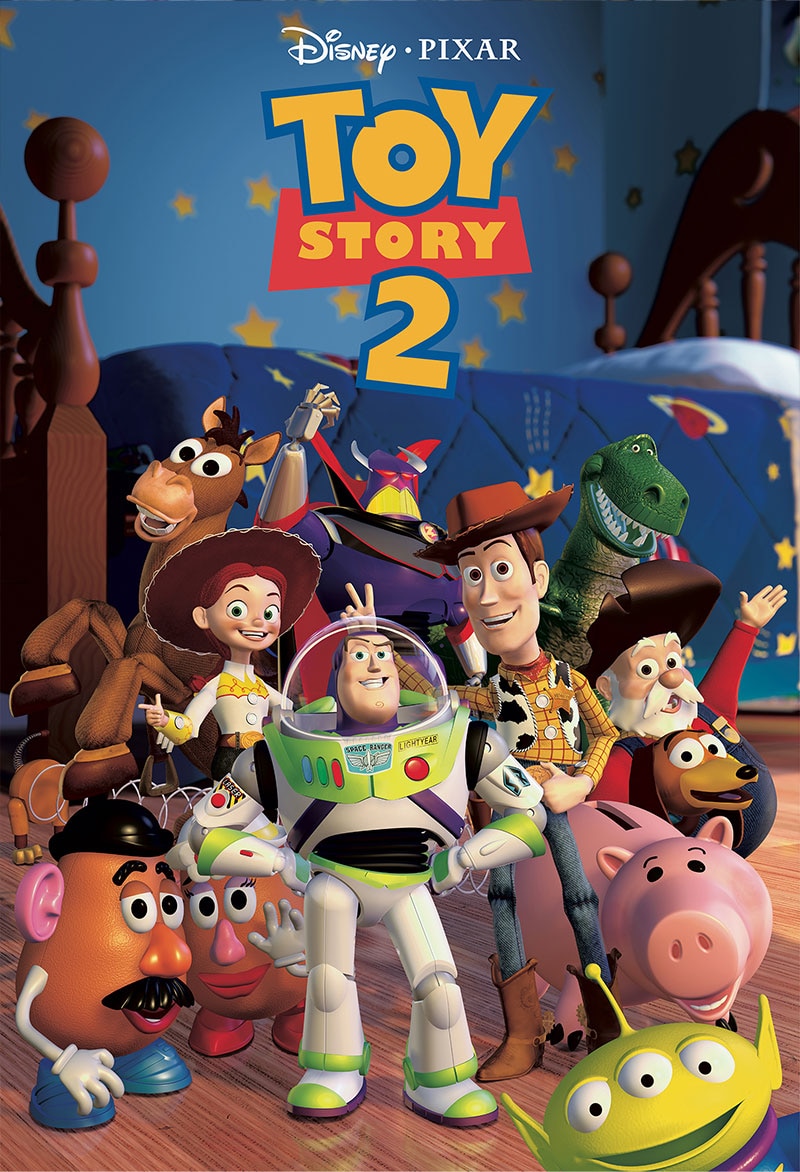
Get ready for the most daring—and hilarious—rescue mission ever! When Woody is kidnapped, Buzz and the rest of the toy gang bravely venture into the outside world to save him. Meanwhile, Woody discovers that he is a rare and highly valuable collectible, destined to be sent to a toy museum in Japan along with cowgirl Jessie and his trusty horse, Bullseye. As he hears Jessie’s story, Woody begins to waver, torn between the allure of fame and his desire to return to his friends. Just as he’s about to make his decision, Buzz arrives, having overcome countless obstacles to rescue him. A heartwarming sequel that celebrates the power of friendship and loyalty.
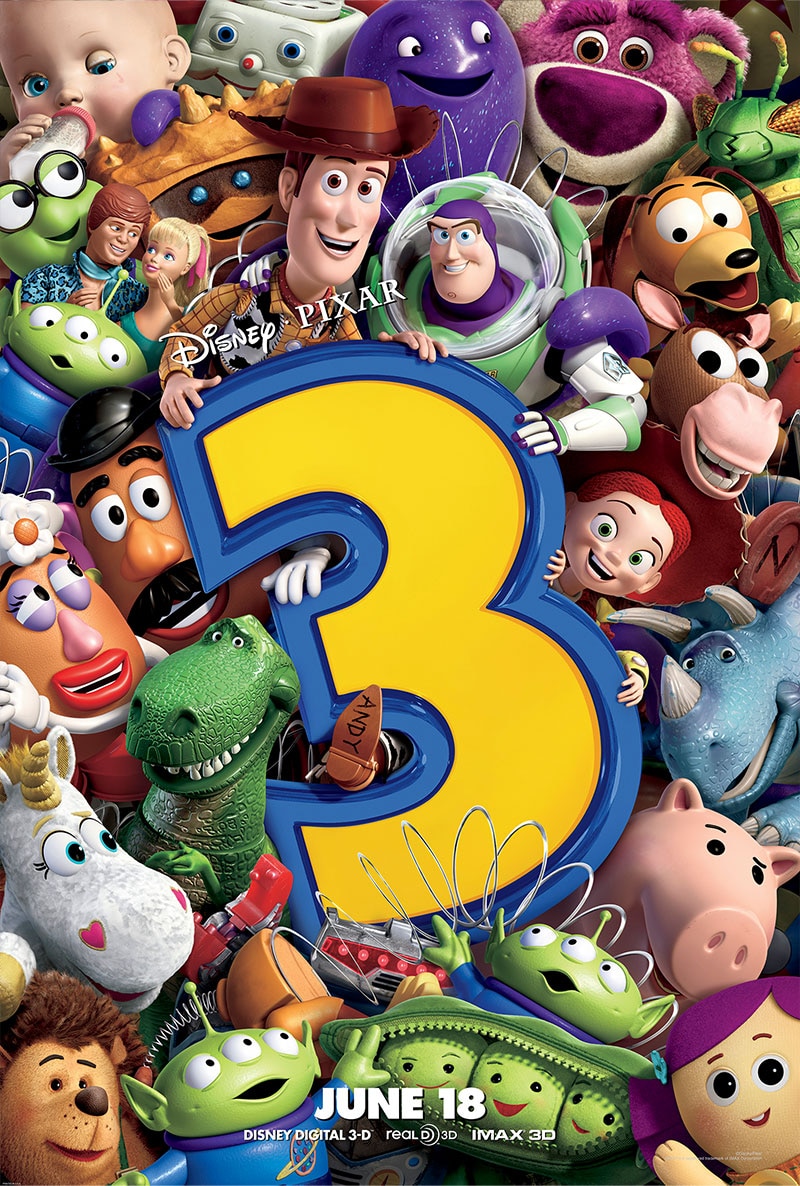
Now grown up and preparing to head off to college, Andy no longer plays with his toys, leaving Woody and the gang uncertain about their future. One day, they are accidentally donated to a daycare center. Buzz and the others are excited to be welcomed by the resident toys, but Woody urges them to return to Andy. Unfortunately, no one listens. Woody manages to escape on his own but soon discovers that his friends are in danger. Determined to save them, he sets out on a daring rescue mission. Even if they manage to escape, what awaits them is an unexpected fate they could never have imagined. A deeply emotional tale of farewell and new beginnings—this is one of the most powerful entries in the Toy Story series.
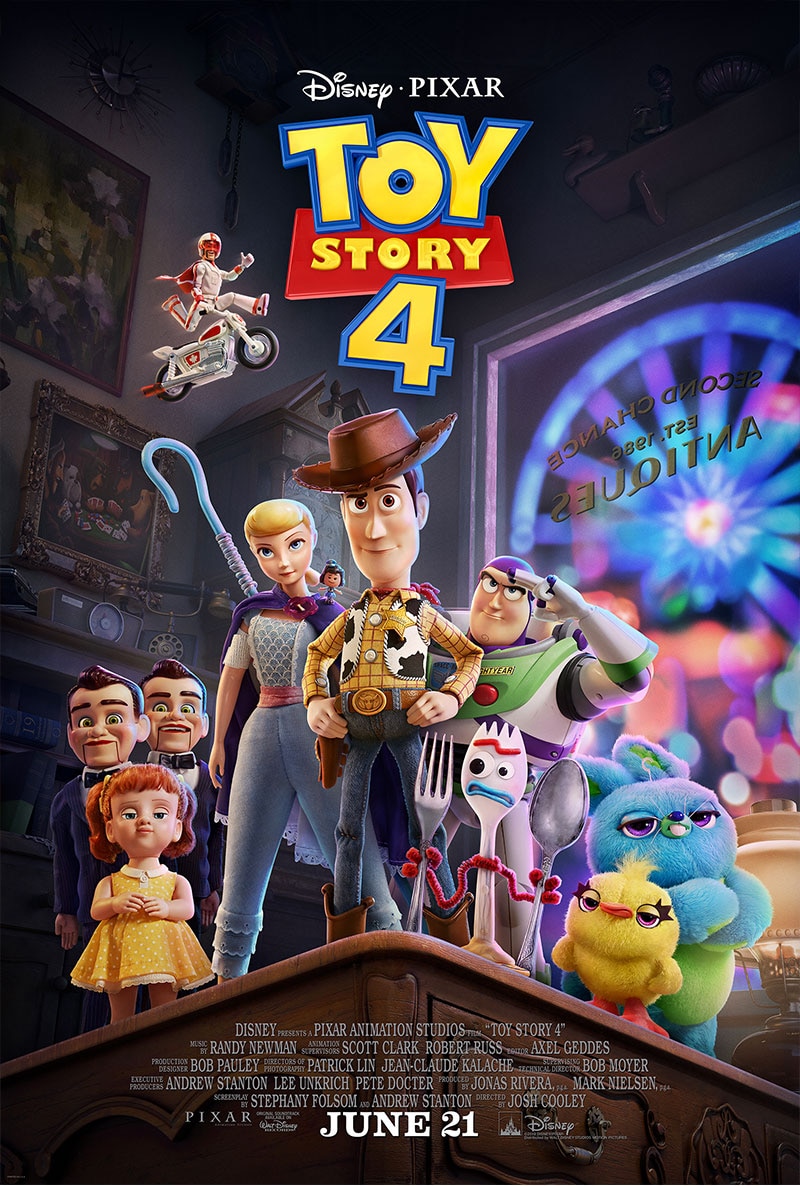
“To a toy, being with a child is everything.”
Now living with their new owner Bonnie, Woody, Buzz, and the rest of the toys embark on a new adventure when Forky—a handmade toy and Bonnie’s favorite—believes he’s just trash and runs away. Determined to bring Forky back, Woody sets off on a rescue mission that leads to a world of unexpected encounters: forgotten toys who have never known love, a thrilling reunion with his long-lost friend Bo Peep, and a journey full of heart-pounding excitement. What new world will Woody discover beyond everything he once knew? A bold new chapter that explores fresh beginnings, enduring friendships, and the courage to choose your own path.
All items
Originally from Michigan and raised in San Jose, Bob Pauley earned a B.S. in Graphic Design from San Jose State University and now lives in Berkeley, California. He joined Pixar Animation Studios in 1993 as a character designer and sketch artist for Toy Story, where he contributed to the iconic design of Buzz Lightyear. He later served as art director on A Bug's Life and production designer on Monsters, Inc., Toy Story 3, and Toy Story 4. A lifelong car enthusiast, he also served as production designer on Cars, helping to shape the characters and world. Outside of film, he worked with Walt Disney Imagineering on the design of Cars Land at Disney California Adventure.
Toy Story Movies 1-4

Toy Story (1995)
Created by Disney and Pixar, Toy Story is the world’s first full-length feature film made entirely with CGI animation. Woody, a cowboy doll, is young Andy’s favorite toy. But everything changes when Andy receives a brand-new, high-tech Space Ranger—Buzz Lightyear—for his birthday. Suddenly, Woody’s status is threatened. As tensions rise between Woody and Buzz, an unexpected twist leads them to be captured by Sid, a boy who enjoys tormenting toys. Facing a significant crisis, the two rivals must work together to escape and find their way back to Andy. Along the way, they began to form a genuine friendship. A heartwarming tale of adventure and connection, told from the perspective of the toys.

Toy Story 2 (1999)
Get ready for the most daring—and hilarious—rescue mission ever! When Woody is kidnapped, Buzz and the rest of the toy gang bravely venture into the outside world to save him. Meanwhile, Woody discovers that he is a rare and highly valuable collectible, destined to be sent to a toy museum in Japan along with cowgirl Jessie and his trusty horse, Bullseye. As he hears Jessie’s story, Woody begins to waver, torn between the allure of fame and his desire to return to his friends. Just as he’s about to make his decision, Buzz arrives, having overcome countless obstacles to rescue him. A heartwarming sequel that celebrates the power of friendship and loyalty.

Toy Story 3 (2010)
Now grown up and preparing to head off to college, Andy no longer plays with his toys, leaving Woody and the gang uncertain about their future. One day, they are accidentally donated to a daycare center. Buzz and the others are excited to be welcomed by the resident toys, but Woody urges them to return to Andy. Unfortunately, no one listens. Woody manages to escape on his own but soon discovers that his friends are in danger. Determined to save them, he sets out on a daring rescue mission. Even if they manage to escape, what awaits them is an unexpected fate they could never have imagined. A deeply emotional tale of farewell and new beginnings—this is one of the most powerful entries in the Toy Story series.

Toy Story 4 (2019)
“To a toy, being with a child is everything.”
Now living with their new owner Bonnie, Woody, Buzz, and the rest of the toys embark on a new adventure when Forky—a handmade toy and Bonnie’s favorite—believes he’s just trash and runs away. Determined to bring Forky back, Woody sets off on a rescue mission that leads to a world of unexpected encounters: forgotten toys who have never known love, a thrilling reunion with his long-lost friend Bo Peep, and a journey full of heart-pounding excitement. What new world will Woody discover beyond everything he once knew? A bold new chapter that explores fresh beginnings, enduring friendships, and the courage to choose your own path.
Lineup
All items
TOP
